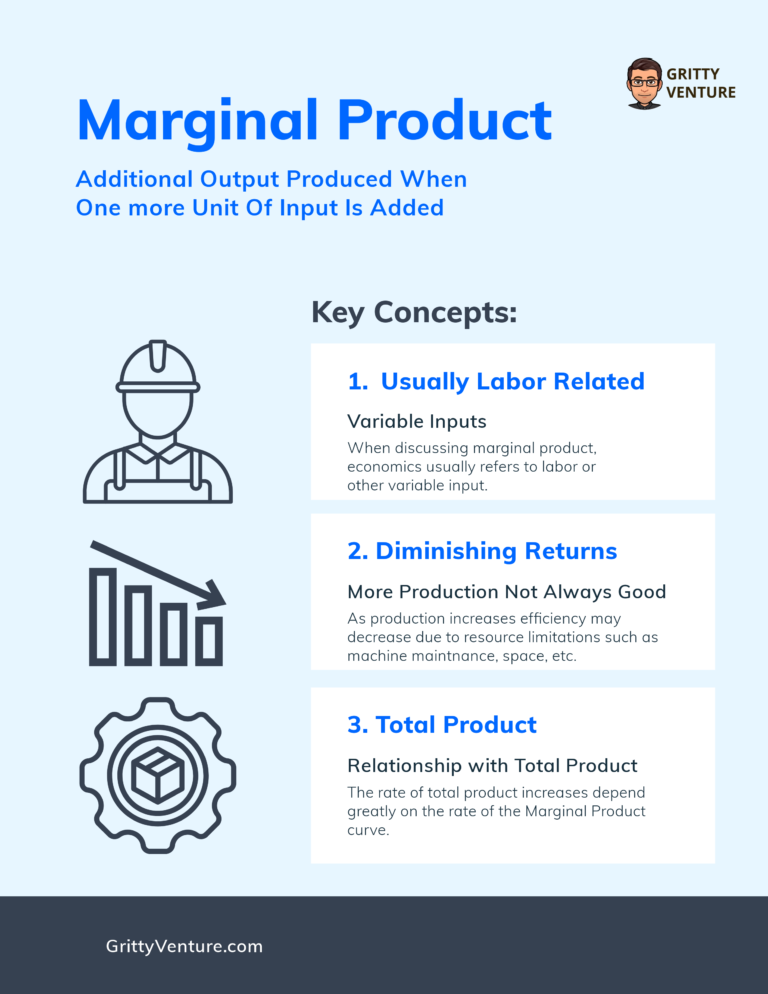In the world of production and business operations, understanding the concept of marginal product (MP) is essential for improving efficiency and maximizing output.
Whether you’re managing a small startup or a large manufacturing plant, knowing how the marginal product behaves can help you make smarter decisions about labor, resources, and production.
What is Marginal Product?
Marginal product refers to the additional output generated by using one more unit of a specific input while keeping all other inputs constant.
In simpler terms, it’s the extra amount of goods or services produced by adding one more worker, machine, or unit of raw materials to the production process.
Mathematically:

Where:
- Change in Total Output refers to the difference in the goods or services produced before and after adding an extra unit of input.
- Change in Input refers to the increase in the resource you use, such as labor, capital, or raw materials.
Marginal Product Example
Imagine a bakery that produces 100 cakes with 5 bakers. If they hire an additional baker and the total output increases to 120 cakes, the marginal product of the 6th baker would be:
- Marginal Product = (120 cakes – 100 cakes) / (6 bakers – 5 bakers) = 20 cakes
This means that the 6th baker added 20 cakes to the total production.
Marginal Product Calculator
Below is a marginal product calculator that I have put together and is free to use. Simply include your email and it will take you to the calculation page.
Once on the calculation page, you can use the calculator without needing to actually submit your email (having a 2nd page helps control the spam).
If you do submit your email you will be taken to a private page on my website where you can access and download Excel files of all the calculators available today and access a link to the Private Facebook Group to continue the discussion (again, without spam!).
The Law of Diminishing Marginal Returns
One key concept related to marginal product is the Law of Diminishing Marginal Returns. This law states that as you continue to add more units of one input (such as labor or capital) while keeping other inputs constant, the marginal product of each additional unit will eventually decrease.
For example, if a factory hires more workers but does not increase the number of machines or space, each additional worker will be less productive than the last. Initially, adding workers may increase output significantly, but after a certain point, the additional output per worker starts to decline.

The Marginal Product Curve
The marginal product curve graphically represents how the marginal product of an input changes as additional units of the input are employed. As you can see above, the curve follows three distinct phases:
- Increasing Marginal Returns: In the initial phase, adding more input leads to a rising marginal product due to better utilization of resources.
- Diminishing Marginal Returns: As input increases further, the marginal product starts declining due to inefficiencies.
- Negative Marginal Returns: Beyond a certain point, adding more input may lead to overcrowding or inefficiencies, causing marginal product to become negative.
Understanding the marginal product curve helps businesses visualize how productivity changes with varying input levels and make informed decisions about resource allocation.
The Relationship Between Marginal Product and Total Product
Understanding the relationship between marginal product and total product (TP) is vital. As more units of labor or capital are added to production, total product increases, but the rate at which it increases depends on the marginal product.
- Increasing Marginal Product: In the early stages of production, adding more units of an input (like labor) often leads to increasing marginal products. This is because workers can specialize, machines can be used more efficiently, and production processes are optimized.
- Decreasing Marginal Product: Eventually, as more input is added, the marginal product will begin to decrease due to the law of diminishing returns. More workers might overcrowd the production floor, or equipment might become overused, leading to lower productivity per additional worker.
- Negative Marginal Product: In extreme cases, adding too many units of input can lead to negative marginal products. For example, too many workers might cause confusion, inefficiency, or even a slowdown in production.
How Marginal Product Impacts Business Decisions
The concept of marginal product plays a crucial role in business decisions, particularly when it comes to resource allocation and scaling operations.
- Labor and Productivity: Managers use marginal product to determine how many workers to hire. If the marginal product of labor is high, it makes sense to hire more workers. However, if the marginal product is low, it might be time to stop hiring or consider investing in technology or training to improve productivity.
- Capital Investment: Marginal product also applies to other resources, such as machinery or raw materials. If investing in new capital improves the marginal product of labor or production, it can be worth the expense. Conversely, when the marginal product of capital starts to decrease, firms may opt to limit new investments.
- Cost Efficiency: By calculating marginal product, businesses can identify the most efficient combination of inputs. For instance, if adding one more worker results in a significant increase in output, the company can justify the added labor cost. However, if the marginal product of additional labor is too low, it may be time to reconsider staffing levels.
Real-World Example: A Bakery’s Labor and Output
Let’s take the example of a bakery to see marginal product in action. Imagine that the bakery currently has three bakers and is producing 150 loaves of bread per day. If a fourth baker is hired, the bakery’s output increases to 180 loaves, so the marginal product of labor (MP) is 30 loaves.
However, if the bakery hires a fifth baker, the output may increase to 200 loaves, but the marginal product of the fifth baker is only 20 loaves – less than the previous worker. As more bakers are added without additional ovens or space, the law of diminishing returns kicks in, and the additional output per worker starts to decline.
Marginal Product and Profit Maximization
To maximize profits, businesses must focus on the point where the marginal product of labor or capital equals the cost of that input. In other words, they should hire additional workers or invest in new equipment only when the additional output justifies the additional cost.
Optimal Allocation of Resources: The key is balancing the marginal product with the marginal cost of inputs. If a company is paying $10 per hour for labor, but the marginal product of labor is only producing $5 worth of goods, then hiring more workers is not cost-effective. On the other hand, if the marginal product is greater than the cost of labor, hiring more workers would lead to increased profitability.
Bringing it Home
Marginal product is a fundamental concept in production and economics, helping businesses optimize their use of labor, capital, and other resources. Understanding how additional units of input affect output allows companies to make more informed decisions about hiring, investing, and scaling operations. By monitoring marginal product and considering the law of diminishing returns, businesses can boost efficiency and maximize their productivity, ultimately driving higher profits.




